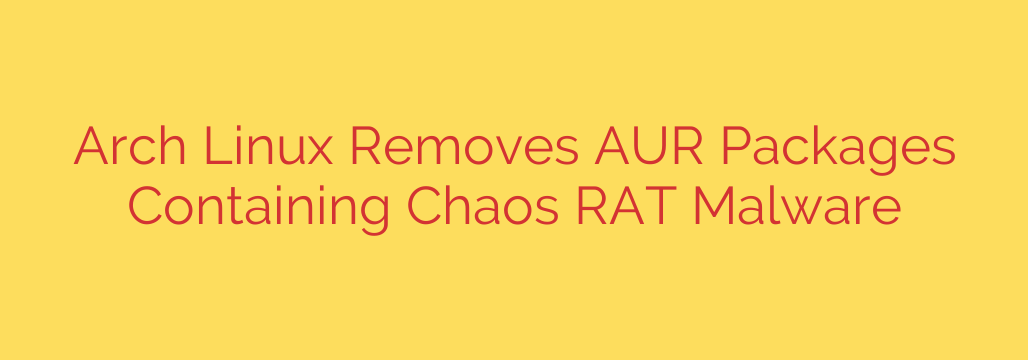
Chaos RAT Malware Infiltrates Arch Linux AUR: A Wake-Up Call for Users
The Arch User Repository (AUR) is a cornerstone of the Arch Linux experience, offering a vast, community-driven collection of software that extends far beyond the official repositories. But this power and flexibility come with inherent risks. Recently, this was starkly highlighted when several malicious packages containing the Chaos RAT malware were discovered and subsequently removed from the AUR, serving as a critical reminder about the importance of user vigilance.
This incident underscores a fundamental truth for all Arch users: the AUR is not a trusted source in the same way as the official repositories. While it hosts an incredible array of useful software, it can also be a vector for attacks if users are not careful.
A Closer Look at the Incident
Security-conscious members of the Arch community identified several packages in the AUR that had been compromised. These packages were designed to look like legitimate or popular software but contained a malicious payload. When an unsuspecting user installed one of these packages using an AUR helper or by manually building it without inspection, the Chaos RAT malware was installed on their system.
The Arch Linux security team acted swiftly to remove the offending packages, but the incident highlights the potential for abuse within a community-managed system.
Understanding the Threat: What is Chaos RAT?
Chaos is not a simple nuisance; it is a potent Remote Access Trojan (RAT) written in the Go programming language. It is a cross-platform malware that can infect Windows, Linux, and macOS systems. Once it infects a machine, it connects to a command-and-control (C2) server, giving the attacker significant power over the compromised device.
Key capabilities of the Chaos RAT include:
- Remote Shell Access: The attacker can execute arbitrary commands on your system.
- Data Exfiltration: It can steal sensitive files and information.
- System Reconnaissance: The malware can gather detailed information about your hardware, software, and network configuration.
- Persistence: It can configure itself to run automatically every time the system starts, ensuring the attacker maintains access.
- Downloading Additional Payloads: The RAT can be used as a foothold to download and run other types of malware.
Having this malware on your system is a severe security breach that can lead to data theft, financial loss, and complete system compromise.
The Core Vulnerability: How This Happens in the AUR
Unlike the official Arch repositories, which are maintained by trusted developers, the AUR is a collection of user-submitted build scripts (PKGBUILDs). These scripts contain instructions on how to download source code and compile it on your machine.
The responsibility for vetting these scripts falls squarely on the user. Malicious actors exploit this by:
- Uploading New Packages: They create new packages disguised as useful tools.
- Orphaning and Hijacking: They adopt abandoned (orphaned) packages that already have some user trust and inject malicious code into their PKGBUILDs.
- Typosquatting: They create packages with names very similar to popular ones, hoping users will install them by mistake.
AUR helpers like yay or paru automate the installation process, which can lull users into a false sense of security, causing them to skip the most critical step: manual inspection.
How to Protect Your Arch Linux System: Actionable Security Tips
The power of Arch Linux comes with the responsibility of securing your own system. Following these best practices will drastically reduce your risk of falling victim to malware from the AUR.
Always, Always Inspect the PKGBUILD: This is the single most important step. Before you build or install any package from the AUR, open the PKGBUILD file in a text editor. Look for suspicious commands. Pay close attention to
sourcearrays and anycurlorwgetcommands that download scripts from unknown or strange URLs. If you don’t understand what a line does, don’t install the package.Check Package Comments and Votes: The AUR website is a valuable resource. Read the comments section for any package you intend to install. Other users will often post warnings if they discover something malicious or broken. High vote counts and a long, positive comment history are generally good signs of a trustworthy package.
Be Wary of New or Obscure Packages: A brand-new package with no votes or comments carries a higher risk. If you need its functionality, be extra thorough in your inspection of the PKGBUILD and the upstream source code.
Verify Package Names: Before you hit install, double-check the package name for typos. Ensure you are installing the official, well-known version of a tool, not a similarly named imposter.
Limit Your Reliance on AUR Helpers: While convenient, AUR helpers can automate you right into a security problem. Use them to search for and manage packages, but always manually review the PKGBUILD before confirming the installation.
Stick to Official Repositories When Possible: If a piece of software exists in the official
core,extra, ormultilibrepositories, always prefer it over an AUR version. These packages are vetted and signed by Arch Linux’s trusted users and developers.
This incident is not a reason to abandon the AUR, but it is a powerful lesson in vigilance. The Arch Linux ecosystem thrives on community involvement and personal responsibility. By treating every AUR package with a healthy dose of skepticism and making security a core part of your workflow, you can continue to enjoy the immense benefits of the Arch User Repository safely.
Source: https://www.bleepingcomputer.com/news/security/arch-linux-pulls-aur-packages-that-installed-chaos-rat-malware/








